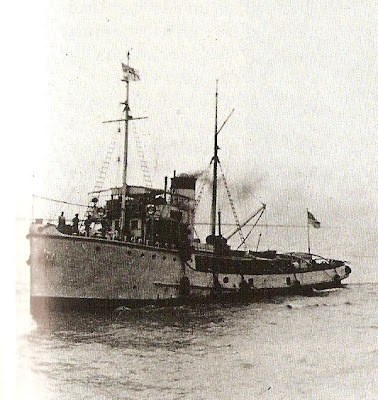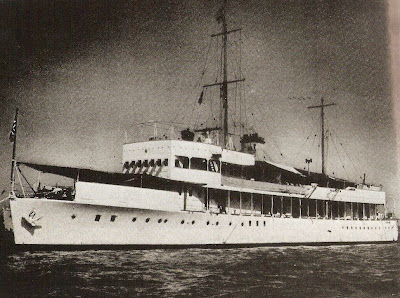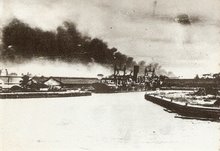Evacuation of Civilians from Singapore December 1941 - February 1942
Michael Pether has complied a list of Ships/Vessels carrying Civilian Evacuees and the dates of departure from Singapore. He has complied this list only for vessels knwon to be carrying civilians and vessels carrying only servicemen have not been included where known. Michael is keen to add names and details where possible and should you have any further information I would be pleased to put you in contact with Michael.
January 1942;
• 16 Jan. “SS. NARKUNDA” with many passengers including a Mrs. Hosking and her children on board. Reached Australia.
• Some time mid-Jan. a British India steamer with probably over 1000 Japanese women and children internees and some allied civilians including a Miss Norah Inge (a missionary). Went to India.
• 23 Jan. – “ISLAM/ISLAMIC” reported to have reached India ( this could be the ship above)
• 30 Jan. “USS WAKEFIELD” with the “WESTPOINT” and “DUCHESS OF BEDFORD” in same convoy which altogether had 4000 passengers. Including a Mrs. McCormac (wife of “You will die in Singapore” author). Went to Tanjong Priok.
• 30 Jan. “USS WESTPOINT”
• 30 Jan. “SS DUCHESS OF BEDFORD” including Mrs. Pelton and Mrs. Barbara Parnell ( nurse with Malayan auxiliary service MAS in Ipoh)
• 31 Jan. “EMPRESS OF JAPAN “with 1221 evacuees including a Mrs. Dora Gurney plus 3 children, to Tanjong Priok where it left again on 15 Jan.
Some time in either January or February;
• “SS. ANGLO INDIAN” which reached Tanjong Priok on 12 February
• “SS. AUBY” (636 tons) reached Tanjong Priok
• “TIEN KWANG/ TUN KUANG” which had many Government servants on board plus RAF , but was bombed and sunk at Pom Pong Island on 14 Feb along with the “SS KUALA”
• “SS. AQUARIUS”(6094 tons) with 110 passengers but was sunk with possibly only 3 survivors
• “SS. NORAH MOLLER” (4433 tons?) which left with 57 passengers, some were women and children. It was shelled and set on fire. Passengers were rescued by the “HMAS HOBART” and the HMS TENEDOS” ,the latter rescued 28 wounded of whom 6 did not survive the voyage to TP which was reached on possible 4 FEB?
• “SILVER GULL” which was towed from RHIO by the famous Capt Bill Reynolds in his converted Japanese fishing boat (later the “KRAIT”) with women and children (totals vary between 166 and 216people) who were mainly families of Dutch Indonesian garrison soldiers on RHIO; they went to Pom Pong Island and then Rengat
• “MADURA” reported to have later sailed from Batavia (TP) in the last few days of Feb.
February 1942;
• 1 Feb. “ROCHUISSEN” a Dutch cattle boat with no passenger accommodation. Took 200 passengers including 50 Malayan Broadcasting personnel (Enid Innes Ker amongst) and reached Tanjong Priok on 5 Feb.
• 4 Feb. “SEDJATRA” a wooden schooner (30 tons) with 4 civilians on board – later left Tjilitap with 5 civilians and 3 RAF
• 6?? Feb. “SS. CITY OF CANTERBURY” with RAF personnel from 453 sqdn. and women and children
• 7 Feb. “HMS BAN HONG LIONG” (1671 tons) with troops and civilians in company with the “SIN AIK LEE” and reached TP from where it sailed again after two days to an unknown destination
• 8 Feb. “SS. PLANCIUS” which later (15 Feb ) sailed again from Tanjong Priok with 840 evacuees ( principally women and children) from ships that had arrived from Singapore, possibly for South Africa according to some, but more likely to Bombay.
• 8 Feb. “SS. MONARCH” sailed for New Zealand
• ?? Feb. “DOMINION MONARCH” for New Zealand
• 8 Feb. in the evening “FELIX ROUSSEL” (Free French ship) with 110 passengers mainly women and children including Mrs. Marjorie Hudson and Mrs. Dorothy Fawcett.
• 10 Feb. “SS. SILVERLARCH” which reached Java
• 10 Feb. “SS. IPOH” (Straits Shipping Co) left with 200 women and children (many were wives of Survey dept. personnel) plus 300 RAF and reached TP on 14 Feb.
• 10 or 11 or 12 Feb. “BULAN/ BULANG” which arrived TP and then went on to Ceylon
• 11 Feb. “AGAN” (244 tons) with 150 civilians including women and children – it either reached Palembang at midday on 13 Feb. or was sunk with the survivors being picked up by the “TENGORRAH”
• 11 Feb. “GIANG BEE” (1200 tons) a Chinese owned coaster with 200-300 old men, women and children on board. It was sunk by Japanese navy and 200-240 passengers were killed or drowned after getting in lifeboats
• 11 Feb. “PING WO” a pre War Yangste steamer of 200 feet in length and with only a 6 foot draft. Had 200 civilian passengers and ended up towing the destroyer “VENDETTA” all the way to Freemantle where it arrived on 4 March.
• 11 Feb. “KLIAS” which reached Palembang
- the next group of ships probably left in the major convoy of up to 40 vessels which actually departed from Singapore harbour (perhaps in groups according to their speed) early on 12 February ,
• 11 Feb. “SS. JALAVIHAR/ JALIBAHAR” ( 5330 tons) suffered heavy bombing through the Durian straits but passed through TP and finally reached Colombo
• 11 Feb. “SS. JALAKRISHNA” sailed at 1700 hours, possibly clearing the harbour on 12 Feb, in the convoy with the “DELAMORE”, “EMPIRE STAR”,”JALIBAHAR” and “LI SANG”. It was damaged by bombing in the Sunda Straits and via TP reached Colombo. Some reports say it carried no passengers but there was a Mrs. Francis Clarke who, with other evacuees from Singapore later boarded the “PLANCIUS” from TP.
• 11 Feb. “EDANG” left with 11 other vessels to form the slower part of the convoy heading for TP
• 11-12 Feb. “LI SANG” sailed about 1730 hours on 11 Feb (might have actually cleared the Harbour on the 12 Feb.)
• 11-12 Feb. “SS. JALRATNA” (3942 tons) sailed on the night of 11 Feb. and reached Tjilitap from where it left again on 19 Feb.
• 11-12 Feb. “ SS. GORGON’ ( 3533 tons0 a Blue funnel Line ship with 358-380 passengers ( the same convoy as the “DURBAN’, “KEDAH”, “STRONGHOLD”, “EMPIRE STAR” and “YOMA”)and reached TP and later Freemantle, Australia.
• 11-12 Feb. “SS. HONG KHENG” ( 6167 tons) which sailed on the night of 11 feb
• 12 Feb. SS. EMPIRE STAR” with 2000 RAF ground crew and service families, it reached Batavia (i.e. TP) on 15 Feb and then sailed on to Freemantle.
• 12 Feb. at daybreak, “HMS. SCOTT HARLEY” with 170 women and 30 men on board including,
o Michael Ashe
o Roland Braddell
o Miss Linda Brash
o Mrs. Annie L Clark ( wife of Norman Clark engineer Govt. Rice Mills)
o Mrs. Elliott / Mrs. Sharpe – Elliott ( a canteen worker with MAS whose husband was a engineer at the Naval Docks)
o Mrs. W.F. Joyce Fitzpatrick ( husband with Singapore Cold Storage)
o Eliza Martin / Mrs. Eric Martin
o Mrs. Enid Miller
o Mr. & Mrs. Pery
o Nessie Rhodes / Mrs. “Dusty” Rhodes of KL
o Winifred Sinclair
o Dr. J. W. Scarff, his wife, two daughters (Elizabeth and Jopin) and 2 boys
o Joan Winchester / Mrs. V. A. Winchester (wife of a vet and whose brother in law was a doctor)
o A Russian mother and daughter (the latter had a hairdressing shop in Raffles Hotel, Singapore)
o The Secretary to the Governor of Singapore – she is described as about 35 years and 16 stone.
o A naval policeman
o Plus possibly a Mr. Potts, Melvin Thompson, Mrs. Duke, and Mrs. Ray “..of the Municipality” and one child
- most of the “SCOTT HARLEY” European passengers on shipped from Batavia on 21 Feb. to Bombay on the “PLANCIUS”. Some then went on to Australia on the “JOHAN DE WITT”. For a full story of the “SCOTT HARLEY” see the item on the COFEPOW website.
• 12 Feb. “SS. REDANG” (531 tons) of the Thai Navigation Co. with 89 passengers including 6 women and 3 children. It was shelled in the Berhala Straits and sunk – some 30 passengers including 4 women and 2 children got away by boat but were captured by the Japanese.
• 12 Feb. “SING WO” a Yangste river boat (2500 tons) left with 230 passengers including Rohan Rivet who authored “Behind Bamboo” ,it was bombed and ran aground at Muntok where passengers were taken prisoner.
• 13 Feb. “FANLING” a motor launch with 47 passengers which was sunk with only 4 survivors in the Banka Straits
• 13 Feb. “HMS CHANG TEH” sunk in the Durian Straits
• 13 Feb. “SS. KUALA” (at the same time as the “MATA HARI and the “VYNER BROOK” mentioned below) with about 500 people on board including a large group of nurses who had been ordered to leave Singapore. It was sunk on 14 Feb at anchor off Pom Pong Island. The following were on board,
o Nurse Brenda Macduff (who today lives in NZ)
o Nurse Jean Smith
o Nurse Edith wood
o Nurse Olive MacFarlane (killed whilst the ship was at anchor in Singapore)
o Nurse “Paddy” Corke (killed in the bombing at Pom Pong Island)
o Nurse MacPherson (who left Pom Pong Island on the “TANJONG PINANG” which was sunk on the way to Sumatra with almost total loss of life)
o Matron Margot Turner
o Nurse Paddy Clarke
o Nursing Sister Marjorie de Malmanche
o Mary Cooper (Irish)
o Mrs. Doughty
o Miss Doughty
o Jenny Doughty (27 years who lost her leg in the bombing and died later in Padang)
o Dr. Elsie Crowe (Singapore Obstetrician)
o Dr. Marjory Lyon (Johore Government Obstetrician and Surgeon)
o Mrs. Madden
o Olga Neubronner
o Mr. Bruce – Smith (a NZer)
o Group Capt. Nunn and his wife (later died in the sinking of the “ROSENBOOM”)
o Mr. G. T. O’Grady a Public works engineer
• 13 Feb. “SS. SING KHENG SENG” of the Straits Shipping Co with 45 crew from the “EMPRESS OF ASIA” and unknown others.
• 13 Feb. “MATA HARI” with 320 passengers including a large group of nurses. It was captured by the Japanese in the Banka Straits and taken into Muntok harbour. Passengers included Nurse Phyllis Briggs who lives today in the UK.
• 13 Feb. “SS. VYNER BROOK” with 200 evacuees, mainly civilians and nurses. Attacked and sunk in the Banka Straits with heavy loss of life. A large group of the nurses were later murdered by the Japanese on a beach with only Vivian Bullwinkle surviving..
• 13 Feb. HONG KWANG” later abandoned in Java on 9 March
• 13 Feb. a small coaster with 12 British men and a woman named Mary Jenkins
• 13 Feb. in the evening “RELAU” a palm oil tanker of the Straits Shipping Co (75 tons) with 66 passengers. It picked up shipwreck survivors along the way ( including 13 from “SCORPION”) but was captured by the Japanese
• 13 Feb. in the evening “BLUMUT” a small craft of the Johore Marine Dept. with 29 passengers. It was captured by the Japanese off Banka around 16-17 Feb.
• 14 Feb. in the early hours, “HMS. KEDAH” a small costal ship of the Straits Shipping Co. with possibly about 750 men, women and children. It reached Batavia. Mrs. Muriel Reilly, a cipher officer to the Governor, was on board.
• 14?? Feb. “SS. BARLINE / BARLANE” with ships named “BARRIER” , BARRICADE” and “FASTNET” – this one may be an inaccurate piece of info .





